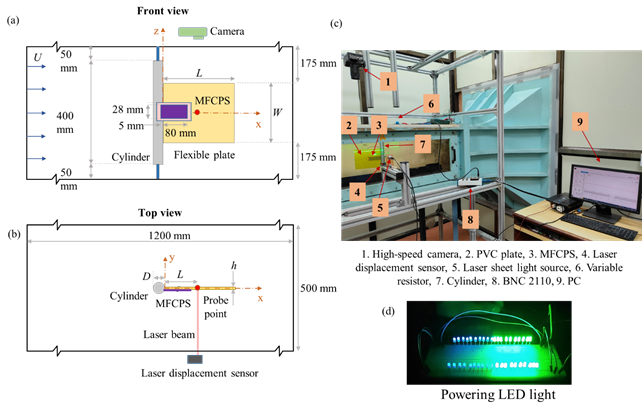Wind Energy Harvesting
In recent years, piezoelectric-based energy harvesters have gained significant attention for capturing small-scale renewable energy from ambient flow sources. While conventional turbines are ineffective at low wind and water flow velocities, energy can be harvested at a smaller scale using flow-induced vibration-based piezoelectric transducers. Additionally, such harvesters are simple in design and easy to integrate into various systems.
 (a) Front view and (b) top view of the schematic of the experimental setup installed in the test section of the wind tunnel. (c) A picture of the experimental setup. (d) Powering LEDs using piezoelectric energy harvesting
(a) Front view and (b) top view of the schematic of the experimental setup installed in the test section of the wind tunnel. (c) A picture of the experimental setup. (d) Powering LEDs using piezoelectric energy harvesting
We experimentally investigate the piezoelectric energy harvesting of ambient wind energy due to the flow-induced vibration of a flexible plate. A piezoelectric sheet is adhered to a thin, flexible plate, and the composite structure is positioned on the lee side of a circular cylinder subjected to a free-stream flow. The front and top schematic views of the experimental setup installed in the wind tunnel test section are shown in Fig. 1(a) and (b), respectively. Fig. 1(c) presents a photograph of the actual experimental setup, highlighting the various components used for setup and measurements. We study seven cases of this simple and novel configuration, comprising only a piezoelectric sheet and a piezoelectric sheet pasted on flexible plates with varying lengths and thicknesses. The wind velocity and the external load resistance are varied in the range of 4.8 to 17.1 m/s and 5 to 100 kΩ respectively to test a large range of practical conditions. We describe the plate dynamics by analysing the displacement, frequency response, phase plane, and oscillation envelopes. In addition, voltage and power output are recorded and analysed. An optimum load resistance for the maximum power output and an optimum velocity for the maximum transduction efficiency are found in the lock-in regime. The maximum power output (order of mW) is observed at different ranges of flow velocities for different cases. Further, a piezoelectric energy harvesting circuit is designed to demonstrate the harvested energy can power multiple LEDs (Fig. 1(d). The piezoelectric sheet pasted on the flexible plate therefore increases power output by two-three orders of magnitude compared to only using a piezoelectric sheet.